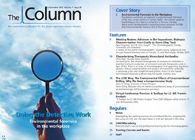The LCGC Blog: The Environmental Effects of Unconventional Drilling: Why We Need a Comprehensive Study
Kevin Schug discusses why we need a comprehensive study of unconventional oil and natural gas (UOG) extraction processes.
Kevin A. Schug, University of Texas Arlington, Texas, USA.
Kevin Schug discusses why we need a comprehensive study of unconventional oil and natural gas (UOG) extraction processes.

Very few research groups are pursuing assessments of the potential environmental impact of unconventional oil and natural gas (UOG) extraction activities in the United States. You could count the major ones on your fingers, with your toes to spare. The reasons for this are manifold. Monetary support for large-scale sampling and analytical studies from traditional funding sources is lacking. The collection and analysis of a large number of samples is time and resource intensive - and, thus, expensive. Ultimately, the cooperation of landowners and other stakeholders at sampling sites can be difficult to coordinate. Pressures from pro- and anti-UOG groups create an enormous polarity for the research topic that brings results of new studies in this area under intense scrutiny. Even then, these results can be overlooked by many based on preconceived notions about the safety or lack thereof of UOG activities.
So far, we have been working for over four years on the topic - in some cases with very limited support. This is admittedly not a long time, but we have assembled a very capable team and network, and together we have performed significant assessments of water1–5 and wastewater6 quality in Texas (a few other studies are pending peer review), in and around areas of UOG extraction. We have assembled a consortium of researchers (http://clear.uta.edu), which I described in a previous LCGC blog post.7 Most recently, and on the heels of a major draft report from the US EPA,8 we published the most comprehensive evaluation of groundwater quality in proximity to UOG activities to date.5
In that study, 550 water wells, including residential, municipal, and agricultural wells in and around the Barnett Shale of North Texas, were sampled and analyzed using a large suite of analytical methods. Bulk water properties, metals, ions, and organics were carefully measured using instruments and methods chosen and compiled based on best practices proffered in various standard methods, but tailored for targeted analysis of chemical compounds relevant to UOG activities. Concessions for untargeted monitoring of unknown compounds were also incorporated into gas chromatography–mass spectrometry (GC–MS) scan events during the targeted analysis. All of the methods were validated and optimized to obtain reliable quantitative data while maintaining the throughput necessary to handle the large set of collected samples. The details of our analytical methods are described in detail in the electronic Supplementary Information for our most recent article (some critics have failed to peruse that resource).5
The findings from our recent study were not benign. Benzene, toluene, ethylbenzene, and xylenes (BTEX) were detected and quantified in 381 out of 550 samples, though, thankfully, most levels were below maximum contamination limits (MCLs) set by US EPA per the Safe Water Drinking Act.9 However, benzene was detected above the 5 ppm MCL in 34 samples. Methanol and ethanol were detected in 34 and 240 water wells, respectively. An unexpected set of chlorinated compounds was detected, including 122 detections of dichloromethane (121 of which were above the 5 ppb MCL) and 296 detections of chloroform (no set MCL). Chlorinated compounds are not used during hydraulic fracturing but are common degreasing agents. If these are indeed from UOG operations, then such findings indicate that a wider view of the potential impact of the multiple processes involved from drilling to extraction to waste disposal must be taken in future work. A series of metals was shown to be elevated in some samples. In general, we found that in areas where UOG activities were greatest, a higher frequency of abnormalities in water quality was detected. It is not my intent to recount all of the details of the study here, as you can read them in the article.
Though many of the chemical species detected in water samples are in common with those used in various UOG processes, a clear link cannot be made. As with the various other reports of this nature, a final conclusion that still more work is needed is certainly valid. While we have been able to muster resources to perform the most comprehensive analysis of water quality to date, a debate about what is comprehensive enough will still ensue. We will continue to objectively evaluate potential sources of the contamination that we detected, as long as we can garner the support and funds to do so. The fact of the matter is that even if the abnormalities we detected in the water samples are not connected to UOG activities, they are still of concern.
Ultimately, a study of the environmental impact of anthropogenic processes, if adverse events are detected, should lead to concerns about associated human health. While many of the chemical species we detected in our recent study were at levels below set MCL values, or were compounds for which no MCL has been established, one worries that the long-term effects of exposure are simply not known. Of course, we live in a world of ever-constant exposure. As I write this, I am returning from the 2015 International Network for Environmental Forensics Conference, which was held in Toronto, Canada. Overall, it was an excellent conference. I heard reports of work where the exposure of firefighters to various chemicals as a result of their response to everything from training fires to the World Trade Center tragedy were studied. These are extreme cases that deserve close investigation, but in everyday life, we are constantly exposed to man-made chemicals at trace levels, the consequences for which no one really knows. Many MCL values are set for acute toxicity responses. Very little is known about the health effects from chronic exposure to low doses of various chemicals over long periods of time.
Frankly, we are only now in the past several years gaining access to analytical instruments and developing associated methodologies that are capable of reliably detecting and quantifying ultratrace exogenous chemicals and their metabolites in biological systems. And, there is a significant need to continue down that path. Low-dose exposures will lead to even lower abundance metabolites; terms such as parts per trillion, parts per quadrillion, femtogram, and attogram will need to become more common vernacular in the analytical literature where limits of quantification are concerned if we are to effectively support large-scale studies to assess the health effects of low-dose toxicants. When such chemicals are found in environmental studies, a next step should be mustering efforts to study their impact on the health of all associated living organisms, not just of humans. But, again, this takes time and resources.
Other obvious steps following the detection of chemicals of concern in the environment should be concerted efforts to remediate the problem, as well as to find the source and eliminate it. In our research consortium, we are actively developing new remediation technologies. The analytical methods we have developed to assess water quality in the environment can also be used to assess the effectiveness of new laboratory-scale water remediation strategies. We also stand willing to collaborate with industry to develop remediation and source elimination efforts. Whether or not the UOG industry is responsible for adverse environmental impact, it would behoove them to work with outside entities in an open and unbiased fashion to evaluate the potential for impact of each component of the UOG process. To date, our consortium has been unsuccessful in bartering such a deal, though we still stand willing. With a little thought, various tracers could be designed and incorporated into processes that involve a significant contact with the environment. Separate tracers could be used when drilling UOG wells (in drilling muds), casing wellbores (in cements), hydraulically stimulating the shale (in hydraulic fracturing fluids), collecting oil and gas, and handling waste (in disposal pits, holding tanks, and transportation vessels). Thus, if a problem is encountered, it could be rapidly diagnosed and fixed. To me, this does not seem like an unattainable dream, but it would require cooperation.
Currently, progress is slow. We can perform a comprehensive study, but some will never consider it comprehensive enough. We can continue to do more, but funding opportunities are sporadic. Reports of chemical contamination, including numerous instances detailed in the US EPA report,8 are met with scrutiny, dismissal, and denial. Many media portrayals fuel debate and exacerbate the polarity of arguments on the benefits versus detrimental effects of UOG operations. Much more science is needed to provide the middle ground and basis for rational decisions to improve understanding and to improve best practices, so that the desires of both sides can be met. In this case, analytical chemistry and separation science sits squarely on top of the most useful resources we have to reach this middle ground. Simply put, more work is needed.
References
B.E. Fontenot, L.R. Hunt, Z.L. Hildenbrand, D.D. Carlton Jr., H. Oka, J.L. Walton, D. Hopkins, A. Osorio, B. Bjorndal, Q. Hu, and K.A. Schug, Environ. Sci. Technol.47, 10032–10040 (2013).
D.D. Carlton Jr., Z.L. Hildenbrand, B.E. Fontenot, and K.A. Schug, “Addressing Concerns About Impacts from Unconventional Drilling Using Advanced Analytical Chemistry,” in Hydraulic Fracturing Impacts and Technologies: A Multi-Disciplinary Perspective, V. Uddameri, A. Morse, and K. Tindle, Eds. (Taylor & Francis/CRC Press, 2016), pp. 115–132.
D.D. Carlton Jr., B.E. Fontenot, Z.L. Hildenbrand, T.E. Davis, J.L. Walton, and K.A. Schug, Int. J. Env. Sci. Technol. in press. DOI 10.1007/s13762-015-0803-4
Z.L. Hildenbrand, A. Osorio, D.D. Carlton Jr., B.E. Fontenot, J.L. Walton, L.R. Hunt, H. Oka, D. Hopkins, B. Bjorndal, and K.A. Schug, J. Chem. (2015). Article ID 957608.
Z.L. Hildenbrand, D.D. Carlton Jr., B.E. Fontenot, J.M. Meik, J. Walton, J.T. Taylor, J.B. Thacker, S. Korlie, C.P. Shelor, D. Henderson, A.F. Kadjo, C.E. Roelke, P. Hudak, T. Burton, H.S. Rifai, and K.A. Schug, Environ. Sci. Technol.49, 8254–8262 (2015).
J.B. Thacker, D.D. Carlton Jr., Z.L. Hildenbrand, A.F. Kadjo, and K.A. Schug, Water7, 1568–1579 (2015).
K.A. Schug, The LCGC Blog, 9 April 2015. http://www.chromatographyonline.com/new-consortium-researchers-environmental-analysis-and-remediation
Assessment of the Potential Impacts of Hydraulic Fracturing for Oil and Gas on Drinking Water Resources (Environmental Protection Agency, Washington, DC, USA, May 2015).
2012 Edition of the Drinking Water Standards and Health Advisories (Environmental Protection Agency, Washington, DC, USA, 2012).
Kevin A. Schug is a Full Professor and Shimadzu Distinguished Professor of Analytical Chemistry in the Department of Chemistry & Biochemistry at The University of Texas (UT) at Arlington. He joined the faculty at UT Arlington in 2005 after completing a Ph.D. in Chemistry at Virginia Tech under the direction of Prof. Harold M. McNair and a post-doctoral fellowship at the University of Vienna under Prof. Wolfgang Lindner. Research in the Schug group spans fundamental and applied areas of separation science and mass spectrometry. Schug was named the LCGCEmerging Leader in Chromatography in 2009 and the 2012 American Chemical Society Division of Analytical Chemistry Young Investigator in Separation Science. He is a fellow of both the U.T. Arlington and U.T. System-Wide Academies of Distinguished Teachers.

The LCGC Blog: Historical (Analytical) Chemistry Landmarks
November 1st 2024The American Chemical Society’s National Historic Chemical Landmarks program highlights sites and people that are important to the field of chemistry. How are analytical chemistry and separation science recognized within this program?







